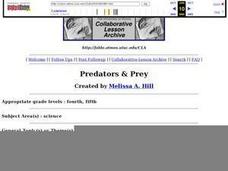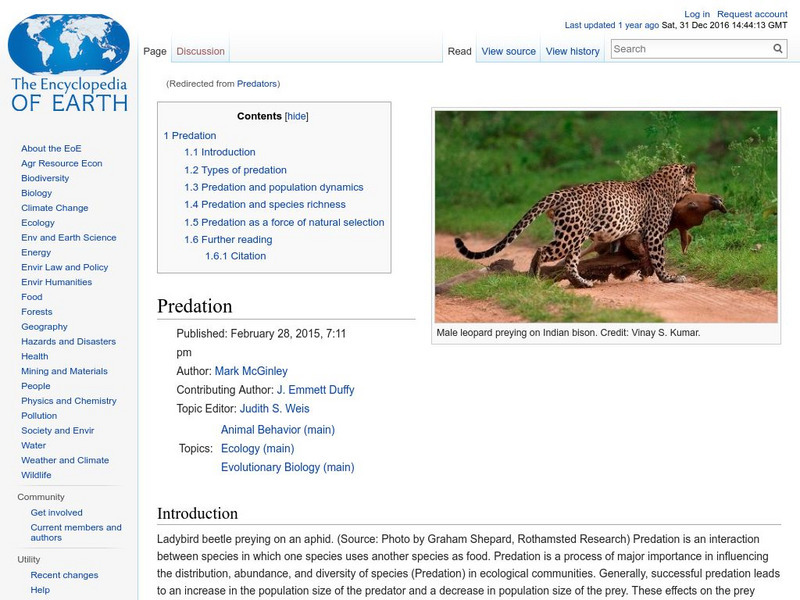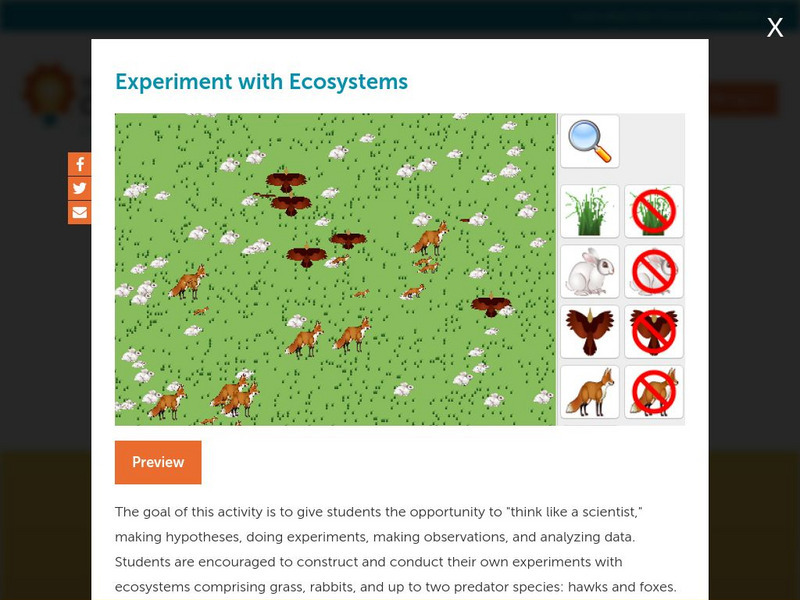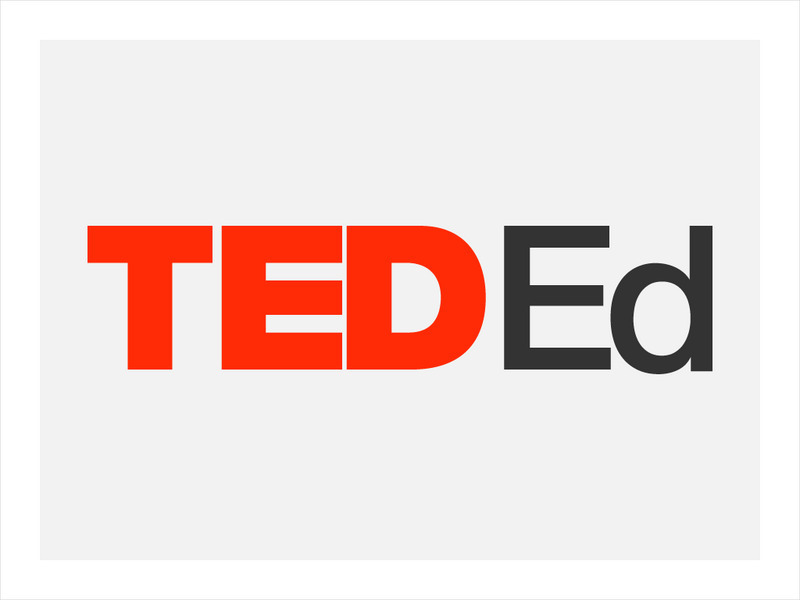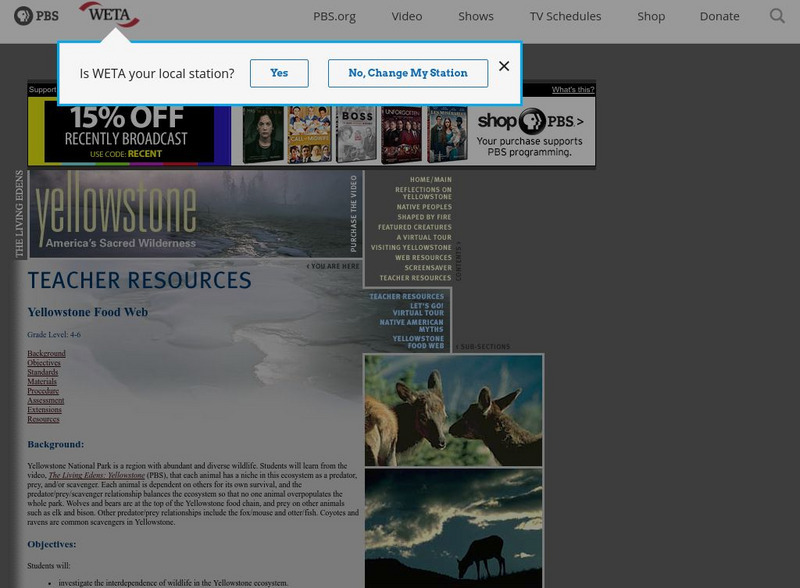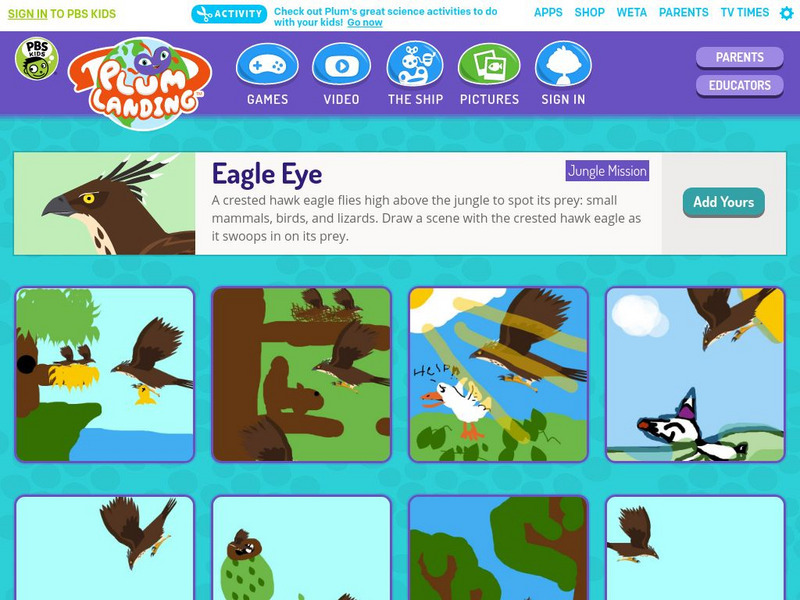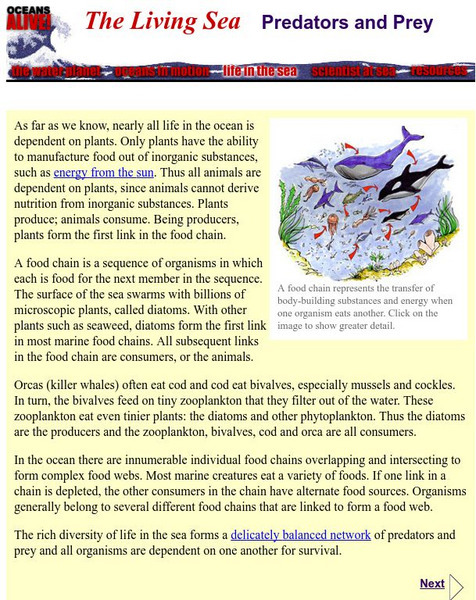Curated OER
Paleoecology of "Fossilized" Owl Pellets
Learners examine fossilized owl pellets to determine how a species environmental preferences allow us to reconstruct probable past environments. Differences in anatomy are used to identify species in this lesson.
Curated OER
Predators & Prey
Young scholars discuss what predators and prey are. Students participate in a playground game aimed at simulating predators and prey.
Curated OER
Birds of Prey
Students explain the predator/prey relationship by researching specific examples of birds (predators) and what they eat to survive (prey).
Science Buddies
Science Buddies: Get Some Practice at 'Fossil' Reconstruction With Owl Pellets
Although this project is not based on actual fossils, you will get good practice at reconstructing an animal's skeleton from individual bones. The goal of this science project is to identify the types of prey that are consumed by owls by...
Encyclopedia of Earth
Encyclopedia of Earth: Predation
Defines the term predation, describes the types, and explains the roles predation plays in population management, in species diversity, and in natural selection. (Published: December 28, 2009)
National Geographic
National Geographic: Coral Reef Food Web
Explore the food web in a coral reef with these illustration. Identify the consumers, producers, and decomposers that are located within this ecosystem. Site includes illustration exploring the different food chains as well as questions...
Other
Pde Sas: Relationships Among Organisms
In this lesson, students compare various types of relationships among organisms (i.e., biotic interactions). Students will: explain the roles of producers and consumers, and predators and prey in an ecosystem. Explain the levels of order...
CK-12 Foundation
Ck 12: Episd: Predation
[Free Registration/Login may be required to access all resource tools.] Discover the predator prey relationship and the ways organisms adapt to predation. Understand the impact predation has on population size and evolution.
DOGO Media
Dogo News: Scrunchies May Save Birds From Fiercest Predator
Read about a wearable device that may help prevent birds from being attacked and killed by cats. Includes video.
Annenberg Foundation
Annenberg Learner: The Habitable Planet: Ecology Lab
Create the parameters of your own ecosystem by choosing which producers and consumers live there. Visualize how the food web operates and species populations change. This simulator mimics the food web within a typical ecosystem and gives...
Other
Kidwings: Virtual Owl Pellet Dissection
A complete lesson on owl pellets. Students can read information, watch a tutorial, and use their computer mouse to complete a dissection simulation right there on the screen.
Concord Consortium
Concord Consortium: Stem Resources: Experiment With Ecosystems
Learn what happens to different populations of organisms as their ecosystem changes. Design your own experiment and make your own guesses with what the result will be with this virtual ecosystem. Also experiment with producer/consumer...
PBS
Nh Pbs: Nature Works: Bony Fish
This site identifies different characteristics and information related to Bony Fish. Find out some fun facts about these friendly fish when you explore this site.
TED Talks
Ted: Ted Ed: From the Top of the Food Chain Down: Rewilding Our World
Our planet was once populated by megafauna, big top-of-the-food-chain predators that played their part in balancing our ecosystems. When those megafauna disappear, the result is a "trophic cascade," where every part of the ecosystem...
PBS
Pbs Teachers:yellowstone: Yellowstone Food Web
Investigate the interdependence of wildlife in the Yellowstone ecosystem and draw an ecosystem showing the interdependence of life forms.
University of Texas at Austin
Univ. Of Texas: Texas Memorial Museum: Creating a Freshwater Ecosystem [Pdf]
An activity where students create a mobile that represent a freshwater ecosystem that appears in nature. Requires Adobe Reader [PDF].
Other
University of Wyoming: Predator Prey Database
You can download a database made by Dr. Robert LaVinge. The database will give you almost every predator prey relationship.
Other
Zephyrus: Food Puzzle Chain
Answer these ten interactive questions about ecological feeding relationships by choosing the correct image that completes each food chain.
PBS
Pbs Kids: Plum Landing: Fence for a Fox
This PBS Kids activity is an extension of a Plum Landing episode featuring foxes in Australia. Students will learn basic information about these foxes. Students will also design a fence to protect chickens from these nonindigenous foxes.
PBS
Pbs Kids: Plum Landing: Link to the Lynx
This PBS Kids activity is an extension of a Plum Landing episode featuring the lynx. Students will learn basic information about the lynx; students will also use online drawing tools to design a scene with a lynx hunting for food.
PBS
Pbs Kids: Plum Landing: Eagle Eye
This PBS Kids activity is an extension of a Plum Landing episode featuring crested hawk eagle in the jungle. Using the online tools, students will draw a crested hawk eagle swooping down to grab its prey.
Science Buddies
Science Buddies: M&m Survival Challenge
In the wild, there are two types of animals: the hunters and the hunted. A good predator is always on the prowl for fresh prey. What can an animal do to stay off of the menu? Find out how some animals use camouflage, and why sometimes it...
PBS
Pbs Learning Media: Catch Me if You Can
Students are asked to explain the predator/prey relationship and how it helps to maintain the balance of the ecosystems.
Museum of Science
Museum of Science: The Living Sea: Predators and Prey
This Museum of Science page does an excellent job of explaining the importance of plants as producers in the sea. The food chain or food web has to start with the plants.



